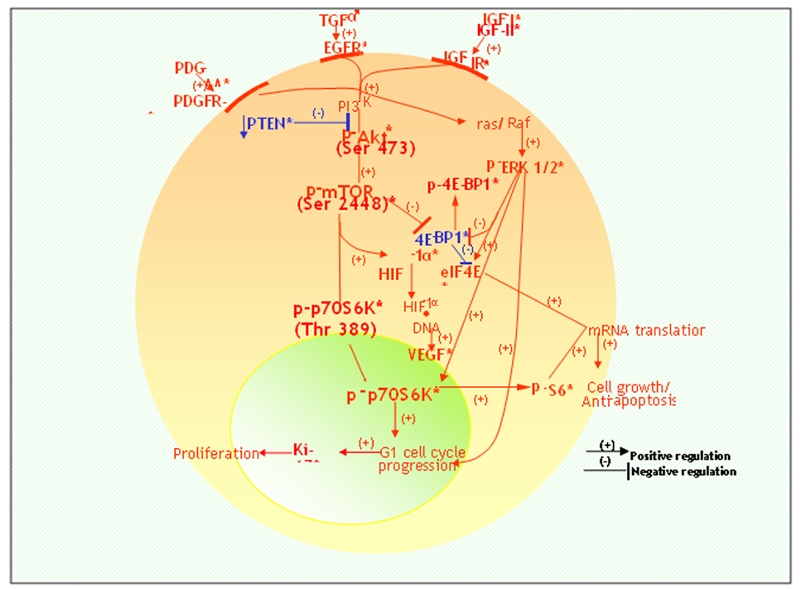Figure 5.

A schematic composite of the complex protein circuitries identified by the authors and others [24–44] utilizing immunohistochemistry in cases of prostate cancer and HGPIN and depicting their interrelationships with the mTOR pathway. Specifically, downstream signaling by the tyrosine kinases, PDGFR-alpha, EGFR and IGF-IR and their signaling ligands, proceeds through the PI3′-K/Akt and ras /Raf kinase/ERK1/2 pathways. The former is facilitated in some cases by a reduction in PTEN, an inhibitor of PI3′-K and leads to phosphorylative activation of mTOR and in turn its effector, p70S6K; and the latter (p-ERK 1/2) converges on p70S6K promoting cell cycle progression. Their impact is evidenced by progressively increased proliferation indices (Ki-67 expression/ percentages) and cell proliferation. Such bipathway stimulation and signal transduction also leads to the phosphorylative inactivation of 4E-BP1 (p-4E-BP1), thereby inhibiting ((−)) 4E-BP-1 and resulting in unbound eIF4E to effect mRNA translation and the synthesis of proteins that promote cell growth and anti-apoptosis. Relatedly, p-p70S6K promotes phosphorylation of S6 ribosomal protein (p-S6) that also participates in mRNA translations. Notably, HIF-1alpha induced by mTOR signaling is relevant to VEGF production and coincides with the increased expression levels of these two protein analytes in prostate cancer and HGPIN. * indicates established immunohistochemical findings with respect to protein analytes; PDGFR: platelet-derived growth factor receptor; TGF: transforming growth factor; EGFR: epidermal growth factor receptor; IGF: insulin-like growth factor; PI3′-K: phosphatidylinositol 3-kinase; PTEN: phosphatase and tensin homologue deleted on chromosome 10; mTOR: mammalian target of rapamycin; ERK: extracellular signal-regulated kinase; HIF: hypoxia-inducible factor; VEGF: vascular endothelial growth factor; 4E-BP1: 4E-binding protein-1; eIF4E: eukaryotic initiation factor 4E.
